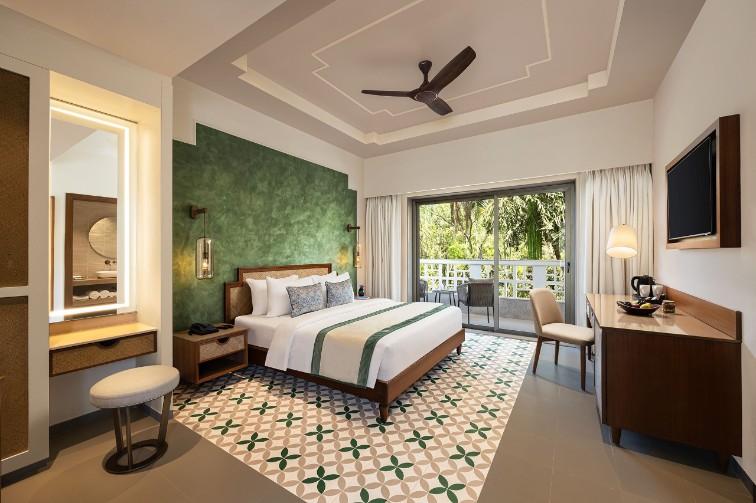
Hotels
•05 min read

North Sikkim has long been a hidden gem for travelers seeking breathtaking landscapes, serene lakes, and enchanting mountainous vistas. Rich in natural beauty and cultural charm, this region offers a magical experience during every season. In this guide, you'll discover the best times to visit North Sikkim for ideal weather, stunning views, and unforgettable memories. Whether you are looking to immerse yourself in nature, capture stunning photographs, or simply escape the hustle of everyday life, our detailed seasonal guide, travel tips, and accommodation recommendations will help you plan the perfect North Sikkim vacation.
North Sikkim experiences four distinct seasons that each offer a unique travel experience. In spring, temperatures begin to warm up, and vibrant blooms like the rhododendrons add a splash of color to the pristine landscapes. Summer brings mild temperatures with clear vistas in the early months, although the later part ushers in the monsoon, which refreshes the region with lush greenery. Autumn showcases crisp weather and rejuvenated landscapes after the rains, ideal for outdoor activities. Winter transforms North Sikkim into a snowy paradise, featuring enchanting frost-covered views and opportunities to engage in winter sports, despite the occasional road closures due to heavy snowfall.
Choosing the right time to visit North Sikkim can elevate your travel experience. Seasonal weather directly influences road conditions, accessibility to attractions, and local festivities. Whether you are in pursuit of snow-capped peaks or vibrant spring blossoms, aligning your trip with your interests ensures that you capture the true essence of North Sikkim. This guide helps you decide the ideal time for your North Sikkim trip by breaking down each season's highlights and challenges.
Spring in North Sikkim is a feast for the eyes. The landscape is transformed with blooming rhododendrons and clear skies that make it one of the most appealing times to travel. Major attractions like Yumthang Valley burst into color with an array of wildflowers, making it a favorite spot for nature lovers and photographers. Visitors during this season often enjoy moderate temperatures and pleasant walks through nature trails, making spring an ideal time if you’re looking for calm and rejuvenation.
During early summer, North Sikkim welcomes travelers with mild temperatures that ease expedition efforts. Attractions remain easily accessible, and the clear weather is perfect for trekking and sightseeing. However, as summer progresses, the monsoon season begins in late summer. Heavy rains could lead to potential travel challenges, but the initial summer months still present excellent opportunities for family vacations and outdoor explorations. This season is particularly appealing for those who prefer mild climates and are keen on enjoying nature without the harsh cold or intense heat.
After the monsoon, autumn in North Sikkim brings a refreshing change. The post-monsoon period revives the greenery and introduces crisp, clear weather that is a delight for travelers. Autumn stands out as an ideal time for photography enthusiasts, as the natural light accentuates the vibrant hues of the landscape. Additionally, local festivals during this season add a cultural zest to your journey, making it a perfect blend of nature and tradition.
Winter is when North Sikkim transforms into a snowy wonderland. With landscapes coated in a pristine layer of snow, destinations like Zero Point and parts of Yumthang Valley offer captivating snowy vistas. However, the charm of winter comes with its own set of challenges; road closures and unpredictable travel conditions require extra planning. Those willing to brave the cold will be richly rewarded with serene, untouched sceneries and a quiet ambiance that few other seasons can match.

Yumthang Valley stands out during spring and early summer for its flourishing flora and vibrant greenery. The valley bursts into life with the blossoming of rare wildflowers and offers a serene environment that beckons nature enthusiasts. Additionally, Gurudongmar Lake becomes more accessible during early summer, its clear and expansive surface reflecting the high-altitude splendor.
Moving into autumn and winter, Zero Point’s snow-laden landscape captures the imagination of travelers seeking winter magic. The pristine snow blanketing the terrain offers an almost ethereal experience, inviting photographers and adventurers alike. Meanwhile, the cultural hubs of Lachen and Lachung provide insight into traditional Sikkimese life and are particularly suited for exploring local customs during these seasons.
North Sikkim offers a variety of lodging options that cater to different budgets and preferences. In areas like Lachen and Lachung, hotels and homestays are designed to provide comfort and convenience, ensuring a homely feel regardless of the season. Many accommodations offer seasonal perks – heated rooms during winter, guided treks and nature tours in the spring, and cozy lounges where guests can unwind after a day’s explorations. These options, combined with warm hospitality, ensure that your stay complements the scenic beauty surrounding you.
Early booking is highly recommended during peak seasons, such as spring and winter, to secure the best accommodations. Off-season discounts can yield significant savings if you are flexible with your travel dates.
Packing appropriately can greatly enhance your North Sikkim vacation. For spring visits, lightweight layers and comfortable trekking shoes are ideal, paired with a windbreaker for cooler mornings. Summer travelers should consider rain gear and quick-dry clothing, especially as the monsoon approaches. Autumn calls for versatile clothing that can transition from warm days to chilly evenings, while winter visitors should prioritize insulated clothing, thermal wear, and sturdy, temperature-adapted footwear.
Traveling during peak seasons often means managing crowds, but with careful planning, you can still enjoy a serene atmosphere. Arriving early at popular spots or choosing alternative viewpoints away from the main trails can make a big difference. Additionally, keeping flexible travel timings and staying updated on local events will help you avoid the busiest periods while still enjoying all that North Sikkim has to offer.

"Did you know? The best time to visit North Sikkim for snowfall is between December and February. However, road conditions can be unpredictable, so always check weather updates and consult local guides before planning your trip."
The best month depends on your preferences. For an enchanting snowy landscape, December-February is ideal. However, if you love flowers and mild weather, March-May is perfect.
The monsoon season, particularly in July and August, is generally challenging due to heavy rainfall and landslide risks.
Snowfall most commonly occurs from December to February, especially in high-altitude areas like Zero Point and Gurudongmar Lake.
Typically, a well-planned trip of 4-5 days is sufficient to explore key attractions such as Yumthang Valley, Gurudongmar Lake, and the cultural hubs of Lachen and Lachung.
Highly-rated accommodations include The Apple Orchard in Lachen and Yarlam Resort in Lachung, celebrated for their excellent amenities and proximity to the picturesque landscapes.
North Sikkim offers a diverse array of experiences in every season, making it an attractive destination for all types of travelers. Whether you're captivated by the blooming vistas of spring, the mild climate of early summer, the vibrant hues of autumn, or the pristine snows of winter, each season presents its own unique allure. By planning your trip in accordance with both the weather and the vibrant cultural backdrop, you can maximize your experience in this stunning region. With details on top attractions, accommodation recommendations, and practical travel tips, this guide serves as a comprehensive North Sikkim travel companion.